Is A $185 Per Pound Pork Product Worth It?
Who doesn’t enjoy trying new products? One of the great advantages of being into food is that there is always something new and different to try. Sometimes, it’s great, and sometimes, it’s not so wonderful.
A while back, we were visiting some friends, and I thought it might be fun to bring something different to their house to serve as an appetizer with a glass of wine. At our local Farmer’s Market, I asked my friend Cheeseman Jack for a great cheese and some cured meat.
Jack, who you might remember, turned me on to that wonderful Chabichou du Poitou cheese, that rich, soft goat’s milk cheese from France. He said he came across some Jamon Iberico de Bellota this time, but it was pricey. I think it is a cured pork product; how expensive can it be? I am shocked to tell you it was $185/pound!
Being interested in trying something pork that cost that much, I was game to taste it, but I could only afford 4 paper-thin slices! It was delicious, but I don’t know if I would have been able to tell the difference between it and some good Italian prosciutto at a fraction of the price.
I did not do a side-by-side taste comparison. After tasting Spain’s finest (and most expensive) pork product, I decided to do a little research to see what I could find out about this ham. What on earth could the Spanish do to this ham to make it worth almost $200/pound? I found out some really interesting information.
Jamon Iberico Spanish Ham
Jamon Iberico de Bellota, often called the “black hoof” ham, is a culinary gem that hails from Spain, specifically the regions of Extremadura, Andalusia, and parts of Castile-La Mancha. It is renowned worldwide for its unparalleled quality, exquisite flavor, and unique production process, making it one of the most sought-after hams in the gastronomic world.
The term “Bellota” translates to acorn in Spanish, a crucial element in producing this exceptional ham. The Iberian pigs, from which this ham originates, are allowed to roam freely in the oak forests, known as “dehesas,” feasting on a diet primarily composed of acorns during the montanera, the final period of fattening before slaughter. This diet rich in acorns imparts a distinct flavor and marbled appearance to the meat, setting it apart from other types of ham.
The production of Jamon Iberico de Bellota is a meticulous and time-intensive process that can take up to four years from start to finish. The journey begins with carefully selecting the Iberian pigs, which must be purebred or crossbred with at least 75% Iberian lineage. These pigs are raised in a free-range environment, allowing them to develop the rich flavors and intramuscular fat that contribute to the ham’s exceptional quality.
After the montanera, when the pigs have reached the desired weight and fat content, they are humanely slaughtered. The hind legs of the pigs are then salted and cured for a period of time, during which they undergo a gradual drying and aging process. This phase is crucial for developing the ham’s complex flavors and achieving the perfect balance of saltiness and sweetness.
The curing process occurs in natural drying sheds where the hams are exposed to the region’s fresh air and climatic conditions. This slow, natural aging process can last anywhere from 24 to 36 months or even longer for some premium varieties. As the ham matures, it develops a deep, ruby-red color, a rich fat marbling, and an intense nutty and savory aroma.
The end result is a ham with a melt-in-your-mouth texture and a complex and nuanced flavor profile. Each slice of Jamon Iberico de Bellota reveals layers of flavors ranging from sweet and nutty to earthy and umami, making it a true delicacy for any culinary enthusiast.
In conclusion, Jamon Iberico de Bellota is not just a ham; it is a testament to centuries-old traditions, meticulous craftsmanship, and the natural bounty of the Spanish countryside. Its exquisite taste and unparalleled quality have earned it a revered status in the world of gastronomy, making it a must-try for anyone with an appreciation for fine food and culinary artistry.
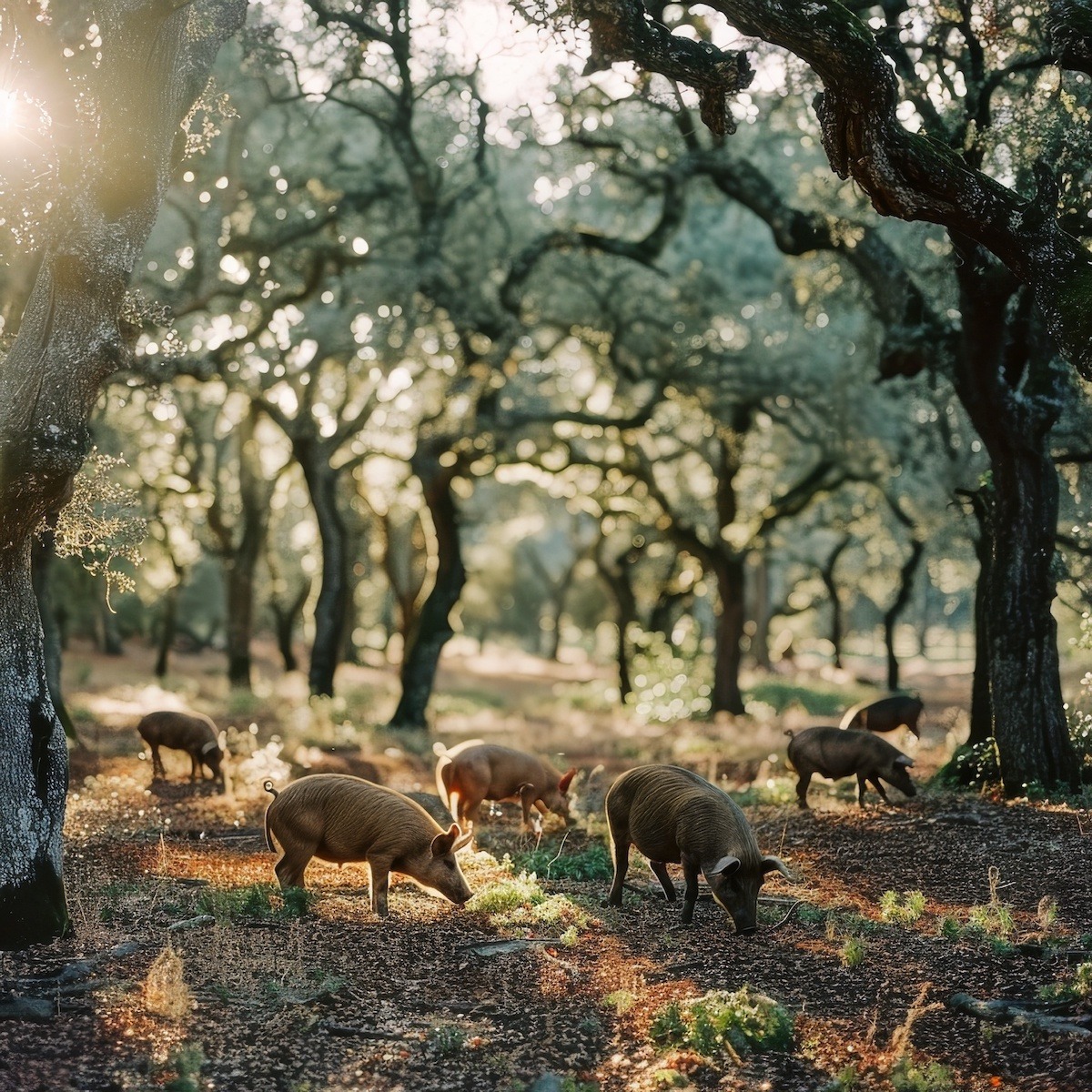
Are the Pigs Wild or Farm Raised?
The Iberian pigs used to produce Jamón Ibérico de Bellota are not wild; they are farm-raised in a free-range environment. These pigs are specifically bred and raised on farms. Still, they can roam freely in extensive oak forests known as “dehesas” during the montanera, the final fattening period before slaughter.
During the montanera, typically from October to February, the Iberian pigs graze on a diet primarily composed of acorns, grasses, and herbs found in the dehesas. This acorn-rich diet is essential for the pigs to accumulate intramuscular fat, which gives the ham its characteristic marbled appearance and contributes to its unique flavor and melt-in-your-mouth texture.
While the pigs are farm-raised, the extensive free-range farming practices in the dehesas play a crucial role in the quality and flavor of the Jamón Ibérico de Bellota. The natural environment of the dehesas, with its oak trees and diverse vegetation, provides the pigs with an ideal habitat to forage and develop the rich flavors that make this ham so special.
How Does Jamón Ibérico de Bellota Compare to Other Jamon?
Jamón Ibérico de Bellota stands out distinctly from other types of jamón due to several key factors contributing to its unique flavor, texture, and quality.
- Breed of Pig: The primary difference lies in the breed of pig used to produce the ham. Jamón Ibérico de Bellota comes from the Iberian pig, a breed native to the Iberian Peninsula. These pigs are known for their ability to accumulate intramuscular fat, which gives the ham its characteristic marbled appearance and rich, melt-in-your-mouth texture.
- Diet: Another crucial factor is the diet of the Iberian pigs during the montanera, the final fattening period before slaughter. Unlike other types of jamón, where pigs might be fed a commercial diet, Iberian pigs can roam freely in oak forests (dehesas), where they feed primarily on acorns, grasses, and herbs. This acorn-rich diet imparts a unique flavor to the meat, characterized by its nutty, sweet, and earthy notes.
- Production Process: The production process of Jamón Ibérico de Bellota is also distinctively different and more time-intensive compared to other types of jamón. The curing period for Bellota ham can last up to 36 months or longer, allowing it to mature and develop its complex flavors slowly. The natural climatic conditions of the region facilitate this slow aging process, contributing to the ham’s unique aroma and taste.
- Quality and Grading: Jamón Ibérico de Bellota is often subject to strict quality controls and grading systems based on the pig’s breed, diet, and length of the curing process. The highest quality Bellota hams are labeled “Pata Negra,” indicating that they come from purebred Iberian pigs. These hams command premium prices due to their superior quality and exceptional flavor profile.
In contrast, other types of jamón, such as Jamón Serrano or Jamón Ibérico de Cebo, come from different pig breeds and are produced using different feeding and curing methods. For example, Jamón Serrano is made from white pigs and undergoes a shorter curing period, resulting in a less fatty and milder-tasting ham than Jamón Ibérico de Bellota.
In summary, Jamón Ibérico de Bellota distinguishes itself through its unique breed of pig, acorn-rich diet, meticulous production process, and superior quality. This makes it a prized delicacy that stands apart from other types of jamón in terms of flavor, texture, and gastronomic experience.
What About the “Good Fat”
Here’s the really interesting part. Because the pigs ate a diet high in monounsaturated fats from the acorns, much of the fat in the ham is oleic acid. This “good fat” has been shown to lower LDL cholesterol. Imagine that?
“Bacon” is good for your cholesterol! I can’t wait to tell my friend Jeff, who believes that nothing on this earth doesn’t go well with either a pork product or chocolate.
As I said, even after researching and discovering Jamon Iberico de Bellota, I’m still unsure I could tell the difference between it and prosciutto. Italian prosciutto and Spanish Jamon Iberico both embody the true spirit of preservation—taking something that would otherwise spoil quickly and treating it with great attention to detail to make a final product that is not only edible but incredibly delicious.
Is Jamon I Iberico de Bellota available in the United States?
You can buy Jamón Ibérico de Bellota in the United States, but it is typically more expensive and less widely available than other ham types. Due to its premium quality and the specialized production process involved, Jamón Ibérico de Bellota commands a higher price point.
Imported Jamón Ibérico de Bellota is subject to strict regulations and inspections by the United States Department of Agriculture (USDA) to ensure its safety and quality. You can find it at specialty gourmet stores, upscale grocery stores, or online retailers specializing in Spanish and gourmet foods.
When purchasing Jamón Ibérico de Bellota, looking for labels that indicate the ham’s quality and authenticity is essential. The highest quality Bellota hams are typically labeled as “Pata Negra” or “100% Ibérico de Bellota,” indicating that they come from purebred Iberian pigs that have been raised on an acorn-rich diet.
Due to its delicate flavor and texture, Jamón Ibérico de Bellota is best enjoyed thinly sliced and served at room temperature to appreciate its complex flavors fully. Pairing it with a glass of Spanish wine, such as a robust red or a fino sherry, can further enhance the gastronomic experience.
While it may require some effort to find and a willingness to invest in this premium delicacy, tasting Jamón Ibérico de Bellota is a culinary experience that is sure to delight any food lover with its unparalleled quality and exquisite flavor profile.
Some of My Favorite Pork Recipes

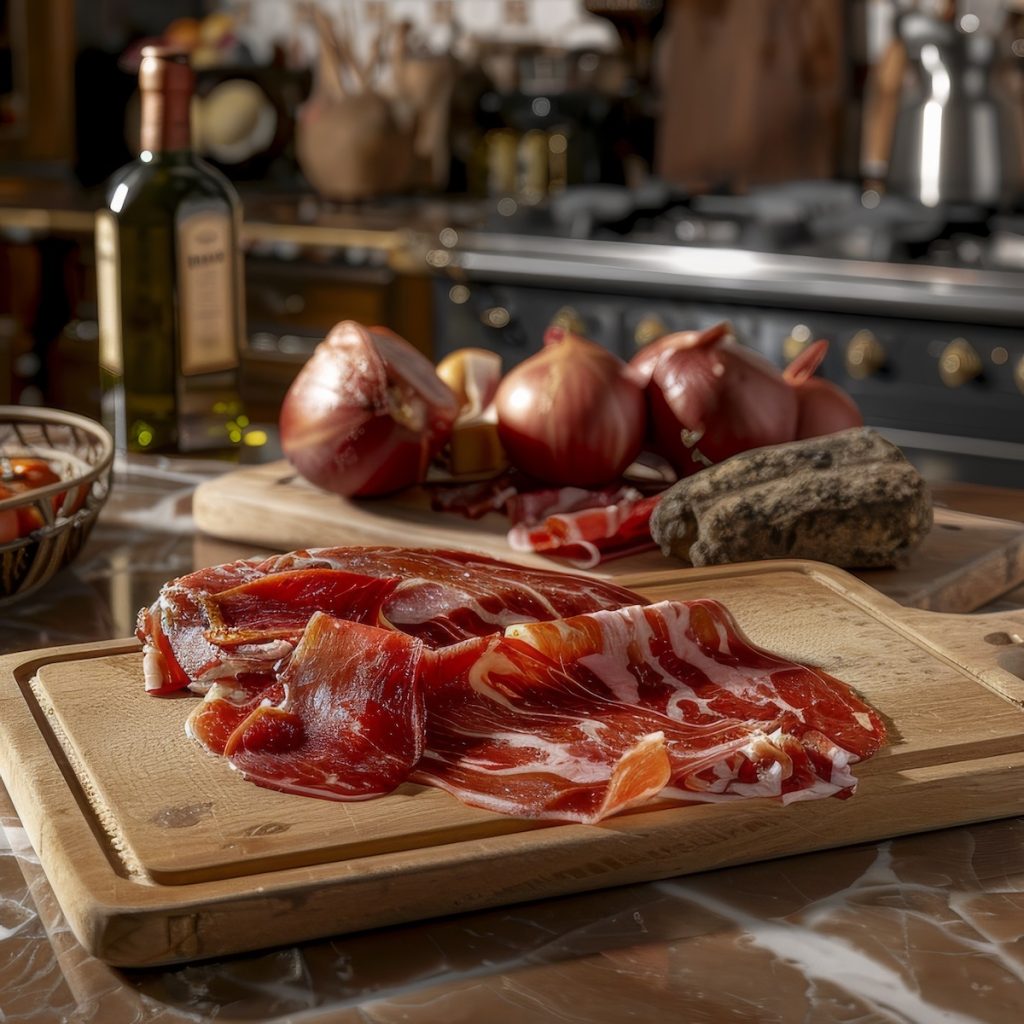
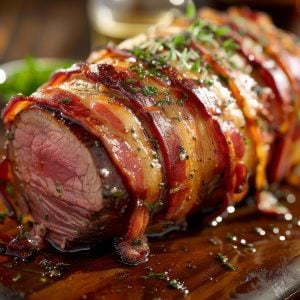
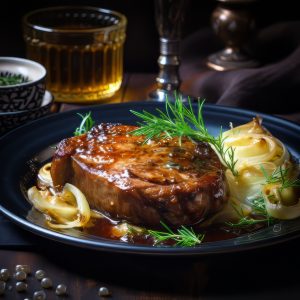

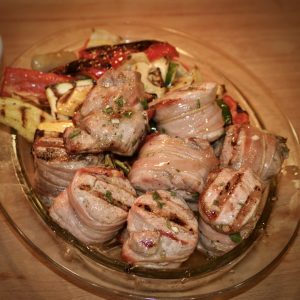
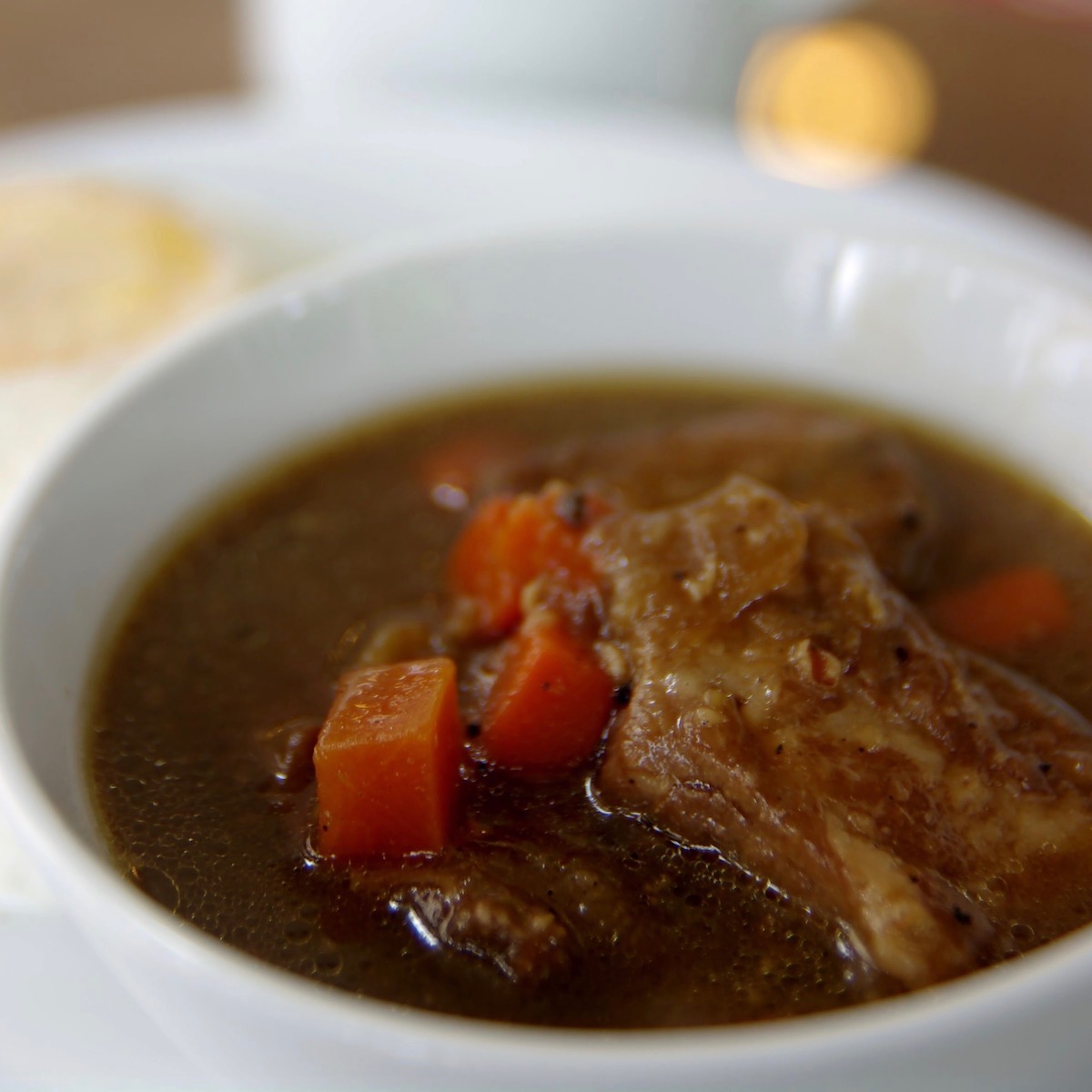
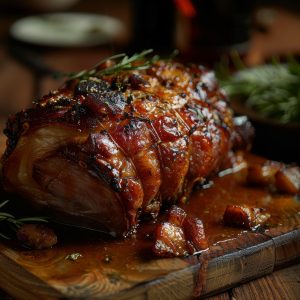

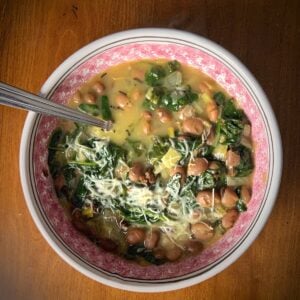
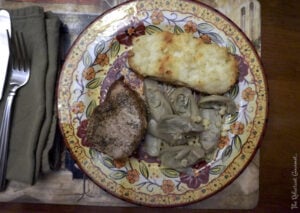


5 Responses
I was surprised to hear about ultra-premium hogs being fed grain, considering all the current discussion of the benefits of grass feeding. So I went to look up whether acorns are technically a grain, or a nut. I can’t really find a definitive answer, but I *did* find this amazing article about the history of human consumption of acorns: http://www.motherearthnews.com/Modern-Homesteading/1984-09-01/Acorns-The-Grain-That-Grows-on-Trees.aspx
Now I want to check my neighborhood for oak trees and keep an eye out this fall.
Hi Drew and thanks for the link to this interesting article. Who Knew? I really like your site and will be spending more time on it and letting my readers know about what you are doing at http://blog.cooklikeyourgrandmother.com/
Great writing! – RG
HI, THE IBERIO IS MUCH BETTER THAN PROSCIUTTO, PROSCIUTTO TASTES LIKE THE CHEAPEST KIND OF SERRANO HAM, NOTHING TO COMPARE TO THE SPANISH SERRANO, BELLOTA , ALSO THERE ARE DIFFERENT TYPES DEPENDING OF THE REGION, TERUEL , GUIJUELO, OR BLACK LEG 5JS FROM SANCHEZ ROMERO CARVAJAL WHICH IS THE MOST EXPENSIVE….. BUT ALL TASTE EXCELLENT …..ALSO NO LEG TASTES THE SAME IS KIND OF LIKE WINE….
Best Jamon Iberico in Spain is 7 Bellotas and now buy online straight from the source in Guijuelo
7bellotas.com
The price is totally worth it. It takes years of raising the animals, feeding the acorns / bellotas and then curing the meat. Aussies can source their supply at Spanish Deli.